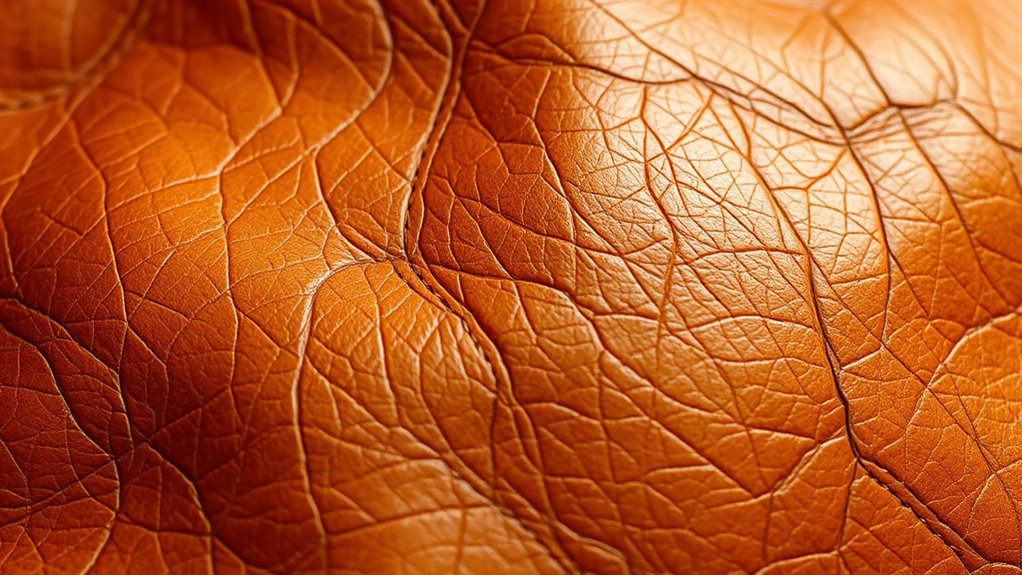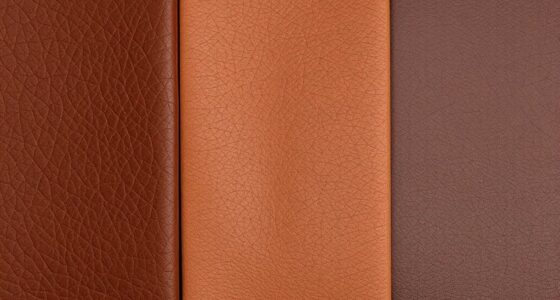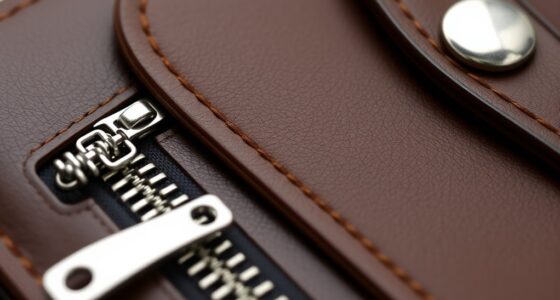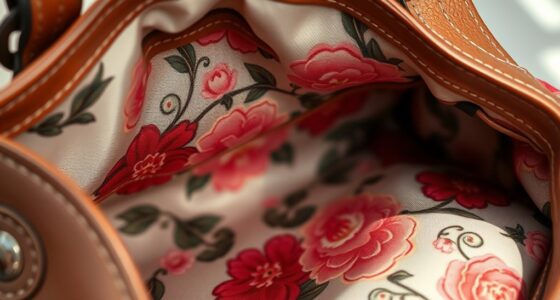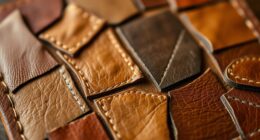The stunning aging of certain leather bags comes from their natural composition, which reacts to oils, moisture, and environmental factors over time. As you use and handle your bag, it develops a unique patina—deepening colors, creases, and character marks—that signifies authentic aging. Oils and waxes enhance this process, while exposure to sunlight and humidity create beautiful surface changes. Want to uncover how different treatments and care influence this natural evolution? Keep exploring to discover more.
Key Takeaways
- Natural aging and exposure to oils, moisture, and handling create unique wear patterns that develop a rich, authentic patina.
- Proper tanning stabilizes the leather’s structure, allowing it to respond to environmental factors and usage over time.
- Oils and waxes penetrate and protect the leather, enhancing color depth and fostering gradual, beautiful aging.
- Environmental factors like sunlight, humidity, and temperature induce chemical reactions, causing color shifts and surface changes.
- Genuine leather’s natural composition and care practices promote a characterful, durable patina, unlike artificially treated leather.
The Composition of Leather and Its Role in Aging

Understanding the composition of leather is essential to grasp how it ages and develops a patina. Leather tanning transforms raw hides into durable material by stabilizing collagen fibers and preventing decomposition. During this process, dye or pigment absorption plays a vital role, as it determines the initial color and how the leather responds over time. When you use and handle leather, oils and moisture seep into its fibers, interacting with the tannins and dyes. This interaction causes subtle changes in color and texture, forming the basis of a beautiful patina. The natural structure of leather, combined with how it’s tanned and dyed, influences its aging process—making each piece unique as it develops character over years of use. Additionally, the composition of leather and its resilience impact how well it ages, contributing to the development of a rich and appealing patina over time. The chemical composition of the leather also affects its ability to develop a desirable patina, making some types more suitable for aging gracefully than others. For example, the presence of natural oils within certain leathers enhances their capacity to develop a rich patina. Moreover, the fiber structure of the leather determines how it responds to environmental factors, further influencing its aging process. A deeper understanding of material properties can help predict how different leathers will develop their unique character as they age.
How Oils and Waxes Influence Patina Development
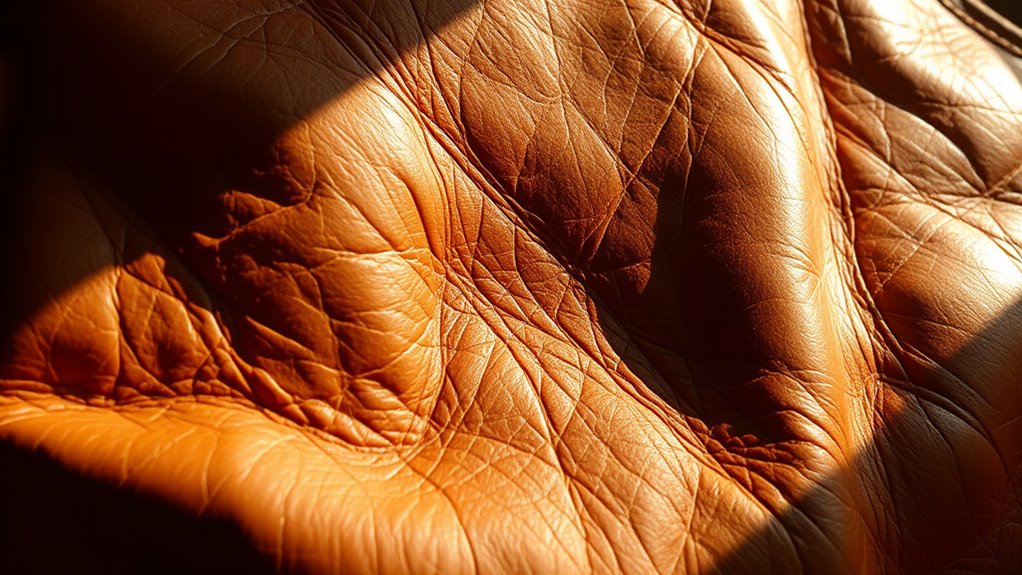
Oils and waxes play an essential role in shaping the character of a leather’s patina by adding depth and richness to its surface. When you apply oils, they penetrate through the leather’s surface, promoting oil absorption that enhances natural color and smoothness. Waxes, on the other hand, form a protective layer through wax layering, which can deepen the patina and provide water resistance. This combination allows the leather to develop unique markings over time. Proper application influences how oils and waxes interact, shaping the evolving look of your bag. Here’s a quick overview:
| Effect | Result |
|---|---|
| Oil absorption | Enhances color and suppleness |
| Wax layering | Adds depth and protective shine |
| Patina development | Creates unique, aged character |
| Surface texture | Becomes richer and more nuanced |
| Longevity | Improves durability over time |
Additionally, understanding the properties of leather helps you better manage how oils and waxes affect its aging process. Recognizing how different application techniques influence the development of patina is crucial for achieving a desired aesthetic over time. Proper maintenance of these layers can also extend the lifespan of your leather piece, keeping it beautiful for years to come. Proper knowledge of manufacturing processes can further aid in selecting the right products to care for your leather.
The Impact of Environmental Factors on Leather Aging
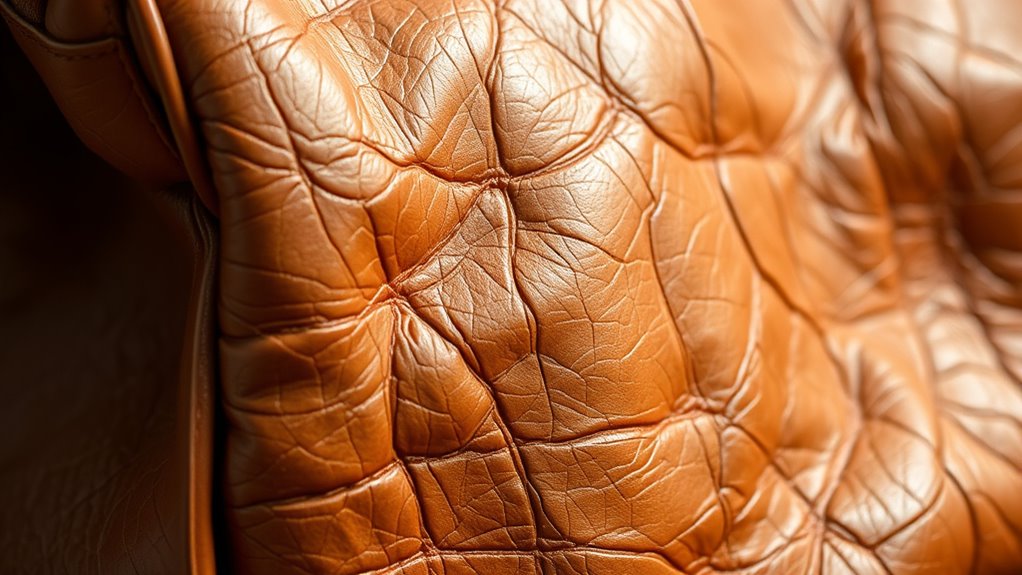
Environmental factors considerably influence how leather ages over time, shaping the development of its patina and overall appearance. Exposure to sunlight, humidity, and temperature fluctuations causes leather oxidation, which alters its surface and color. UV rays can break down leather’s fibers, leading to fading or darkening in specific areas, while humidity accelerates natural aging processes, causing the leather to develop a richer, more textured look. Sudden changes in temperature can cause the leather to expand or contract, creating subtle creases and character marks. Over time, these environmental influences contribute to a unique, lived-in aesthetic that many value. Additionally, oxidation processes play a crucial role in the development of leather’s patina, emphasizing the importance of understanding how environmental exposure impacts leather’s aging process. Recognizing the role of environmental exposure allows leather enthusiasts to better appreciate the natural evolution and beauty of their leather bags, especially as environmental factors interact with the leather’s unique properties. Furthermore, advances in leather preservation techniques can help maintain the leather’s integrity while still allowing it to age gracefully.
Chemical Reactions That Create Unique Colorations

Chemical reactions within leather are responsible for creating the rich, varied hues that develop over time. When exposed to air, moisture, and oils, chemical reactions like oxidation and tanning processes occur, triggering color transformations. These reactions cause the leather’s surface to darken, deepen, or develop unique patinas, giving each piece its distinct character. The natural tannins in the leather interact with environmental elements, resulting in subtle shifts in hue. The tanning process used in leather production influences how the leather ages and the types of reactions that occur over time. Additionally, the tanning method can determine the speed and nature of patina development. Heat and friction also accelerate certain reactions, enhancing the overall color evolution. As you use and aging your leather bag, these ongoing chemical reactions continuously shape its appearance, making each item uniquely beautiful. The oxidation process plays a significant role in the development of rich hues over time. Environmental factors like sunlight and temperature fluctuations can further influence the rate and style of patina formation, and the presence of natural oils can also intensify the aging process, adding to the leather’s unique character. Understanding these processes helps you appreciate the natural, dynamic beauty that develops through authentic aging. Additionally, the presence of environmental factors such as sunlight and temperature fluctuations can further influence the rate and style of patina formation.
The Difference Between Natural and Treated Leather Patinas
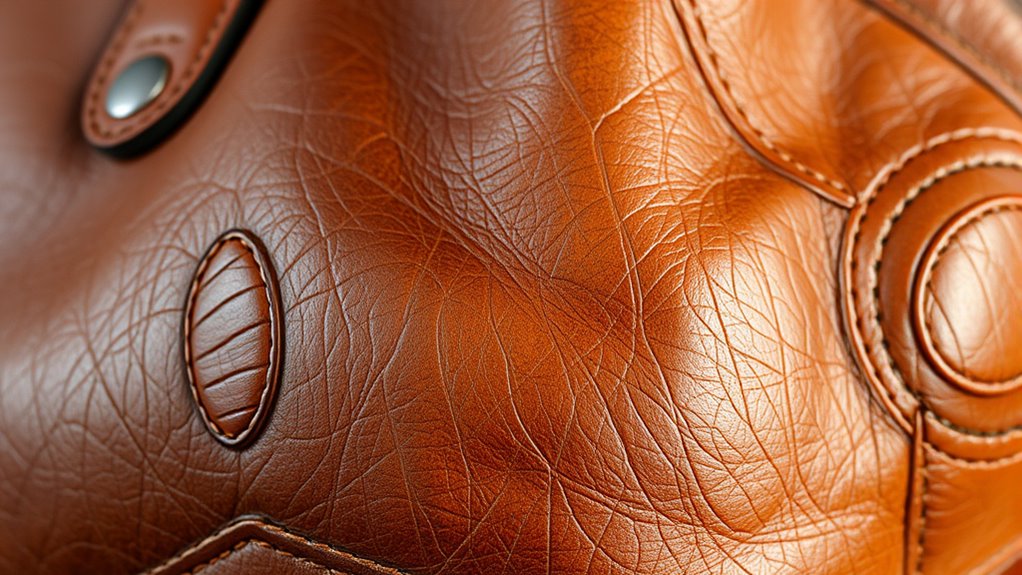
You’ll notice that natural and treated leather patinas develop differently over time. Natural aging shows unique character and changes as the leather responds to use, while treated leather often maintains a more uniform look. Understanding these differences helps you choose the right option for longevity and ease of maintenance. Additionally, applying protective finishes can influence how the leather ages and its overall appearance over time. Proper leather care practices can also prolong the beautiful aging process and preserve the material’s integrity. Being aware of the types of leather can further guide you in selecting the best care routine for your bag.
Genuine vs. Artificial Process
Understanding the difference between genuine and artificial leather patinas is essential if you want your leather pieces to age beautifully or maintain their original appearance. Genuine patinas develop naturally through exposure to oils, moisture, and handling, allowing dye penetration to enhance depth and character over time. In contrast, artificial treatments involve applying chemicals or dyes that create an even, uniform look initially. These treatments often aim to mimic natural aging but don’t respond to wear and environment the same way genuine leather does. While artificial processes may offer predictable results, they lack the unique, evolving qualities of genuine patina. Recognizing this distinction helps you choose leather that ages gracefully and develops authentic character, rather than one that simply looks aged from the start. Additionally, understanding leather aging processes can help you better care for and preserve your leather items over time, ensuring they develop a beautiful patina naturally and enduringly.
Visual Aging Differences
Natural and treated leather patinas age quite differently in appearance. With natural leather, dye saturation varies over time, creating a unique, uneven look that enhances character. You might notice rich color deepening in some areas while fading in others, giving the bag a distinct personality. Because natural leather isn’t heavily treated, it’s more prone to color bleeding if exposed to moisture or friction, which can add to its aged charm. Treated leather, on the other hand, often maintains a more uniform appearance due to the sealed surface. Its dye saturation remains relatively stable, and color bleeding is minimal. This results in a smoother, more consistent patina over time, but it might lack the organic, evolving beauty that natural leather develops through aging.
Longevity and Maintenance
While natural leather often develops a unique, durable patina that shows signs of aging with proper care, treated leather generally maintains its appearance longer with minimal maintenance. Natural leather’s leather dyeing process allows it to age gracefully, enhancing character over time. To preserve its look, you should focus on moisture control, preventing excessive dryness or dampness that can damage the leather’s surface. Treated leather, on the other hand, benefits from protective finishes that resist stains and wear, reducing the need for frequent cleaning or conditioning. This treatment helps maintain a consistent appearance and extends the bag’s lifespan. Overall, natural leather requires more attentive maintenance, while treated leather offers easier upkeep, making it ideal if you prefer a low-maintenance option without sacrificing durability.
The Significance of Leather Thickness and Grain
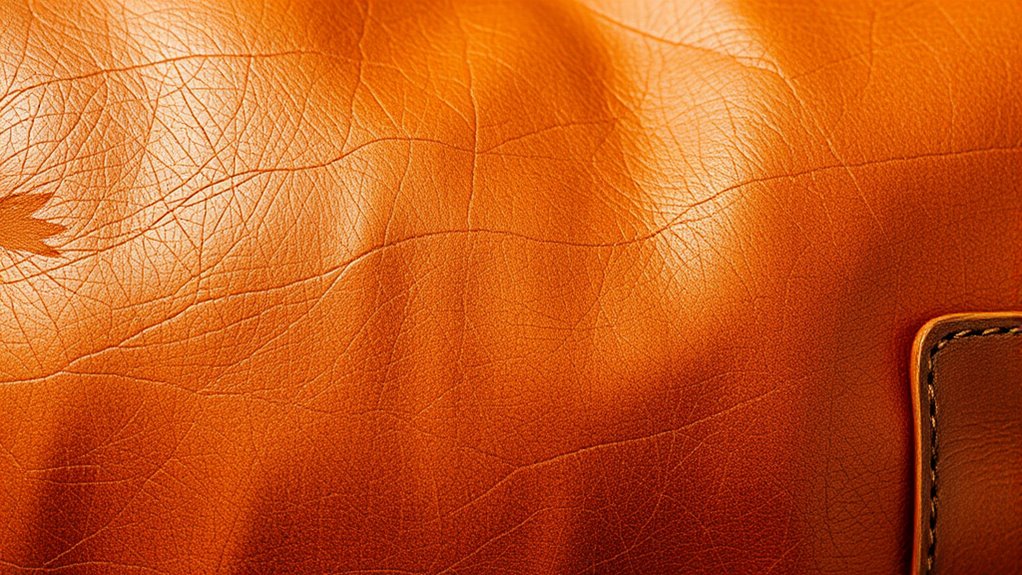
Your choice of leather thickness and grain directly affects how your item ages and wears over time. Thicker leather tends to be more durable and develops unique wear patterns, while grain variations influence texture and character. Understanding these factors helps you predict how your leather will evolve and look with age.
Durability and Wear Patterns
Leather thickness and grain play essential roles in determining how well a piece will hold up over time. Thicker leather generally resists surface cracks and maintains structural integrity, while grain quality influences how it ages. As you use your bag, expect natural wear patterns like color variation and gentle surface cracks that add character. The table below highlights how different factors affect durability:
| Leather Thickness | Grain Quality | Wear Pattern Impact |
|---|---|---|
| Thicker leather | Fine grain | Less surface cracking |
| Thin leather | Coarse grain | More color variation |
| Moderate thickness | Smooth grain | Even aging, fewer cracks |
| Heavy-duty leather | Textured grain | Develops unique surface cracks |
| Soft leather | Porous grain | Shows early signs of wear |
Understanding these factors helps you anticipate how your leather will age gracefully.
Grain Texture Variations
Grain texture variations markedly influence how leather ages and develops character over time. Your leather’s unique grain pattern, including surface irregularities, plays a vital role in its aging process. A tight, uniform grain often results in a smoother surface, which may develop a refined patina with wear. In contrast, leather with noticeable surface irregularities or a more open grain tends to create a richer, more textured appearance as it ages. These variations affect not only the aesthetic appeal but also how the leather responds to environmental factors like moisture and friction. By understanding your leather’s grain pattern, you can better anticipate how it will evolve, ensuring your bag gains a beautiful, personalized character that reflects its unique texture and history.
Aging and Patina Development
The development of a rich patina depends heavily on both the thickness of the leather and its grain structure. Thicker leather tends to age more gracefully, developing deeper, more complex hues over time, reflecting historical influences on craftsmanship. The grain’s durability influences how the leather wears, with finer grains often showcasing subtle markings that add character. These qualities hold cultural significance, as they connect you to traditional methods passed down through generations. Leather with a robust grain and adequate thickness will age beautifully, revealing layers of history and personality. You’ll notice how the patina tells a story—each scratch, crease, or color shift echoes its journey, making your bag a unique artifact of personal and cultural history.
How Handling and Use Accelerate Patina Formation

Handling and regular use expose surfaces to oils, sweat, and environmental elements that directly influence patina development. As you handle your leather bag, wear patterns begin to form, highlighting areas of frequent contact. These patterns create a unique look, telling your story through subtle color shifts and surface changes. Your handling techniques also play a role; for example, gripping or resting your bag in certain spots accelerates this process. The natural oils from your skin seep into the leather, encouraging oxidation and color deepening over time. Every touch, fold, and movement adds to the evolving character of your bag. By using it regularly—and with mindful handling—you actively contribute to the beautiful aging process that makes each leather piece uniquely yours.
Common Myths About Leather Aging Debunked
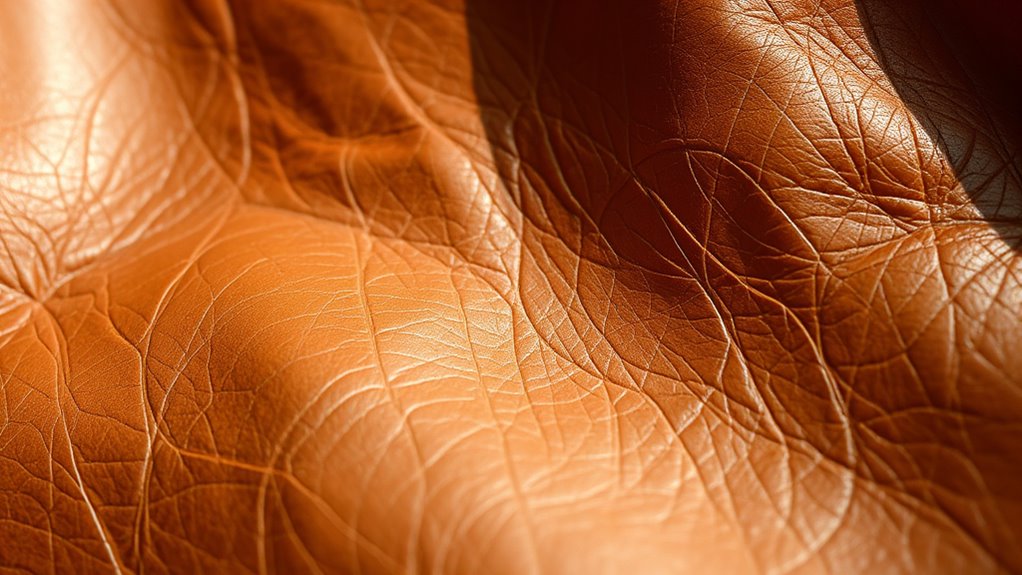
Many people believe that leather must darken considerably or develop a worn look quickly, but these are common misconceptions. Leather aging isn’t solely about visible wear; it’s a natural process influenced by factors like dye saturation and finish types. Some think synthetic coatings prevent patina, but they mainly protect surface appearance and can limit natural aging. Others believe that increased dye saturation speeds up aging, but it mainly affects initial color depth without impacting how leather develops character over time.
| Myth | Reality |
|---|---|
| Leather must darken rapidly | Aging occurs gradually with use and exposure |
| Synthetic coatings stop patina | They protect but don’t prevent natural aging |
| More dye saturation speeds aging | It influences color, not aging process |
| Worn look equals old leather | Patina can develop beautifully without damage |
Techniques to Enhance and Preserve Your Leather’s Patina

To enhance and preserve your leather’s patina, you need to adopt specific care techniques that support natural aging while protecting the material. One effective method is using gentle dyeing techniques to subtly refresh the leather’s color without disrupting its character. This can involve applying specialized dyes or conditioners that deepen the existing hue, helping the patina develop uniformly. Additionally, paying attention to stitching patterns matters; reinforced stitching not only strengthens the bag but also ensures the leather ages evenly. Regular cleaning with a soft cloth and conditioning with leather-specific products maintain suppleness, preventing cracks that could damage the patina. By combining thoughtful dyeing techniques and well-crafted stitching patterns, you safeguard your leather’s unique aging process, allowing its beauty to deepen over time.
Selecting Leather That Will Age Gracefully
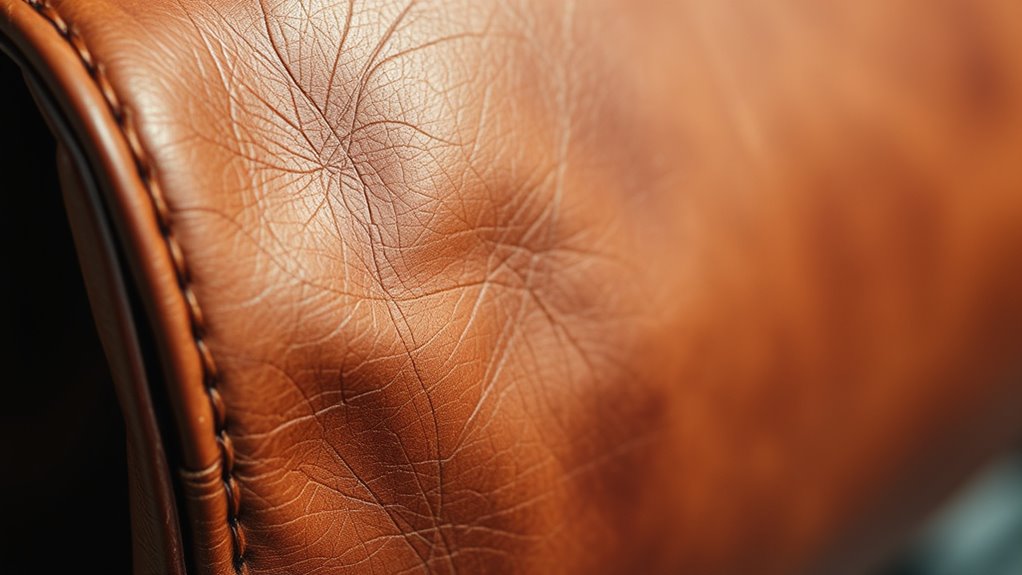
Choosing the right leather is essential if you want your item to develop a beautiful patina over time. Genuine full-grain or top-grain leather naturally ages well, revealing character and richness. Be cautious with vegan alternatives, as they often lack the depth that develops with real leather, though some improve with proper care. Synthetic finishes can protect the surface but may hinder the natural aging process, preventing a true patina. To ensure graceful aging, look for leathers that breathe and absorb oils, which help develop that desirable aged look.
- Opt for full-grain or top-grain leather
- Avoid overly processed vegan options
- Choose natural finishes over synthetic ones
- Consider leather that’s untreated or minimally processed
Frequently Asked Questions
How Does the Type of Leather Influence the Development of Patina?
You’ll notice that the type of leather, especially the leather grain, greatly influences how your bag develops patina. Full-grain leather, with its natural surface, ages beautifully as it retains more of the hide’s original character. Tanning processes, like vegetable tanning, also impact patina formation by creating a more receptive surface for oils and wear to develop a rich, unique patina over time.
Can Artificial Aging Techniques Replicate Natural Leather Patina?
You might think artificial aging techniques can perfectly mimic natural leather patina, but they often fall short. Chemical treatments used in artificial aging can create a look that seems authentic, yet it lacks the depth and character developed over years. While these methods can enhance appearance quickly, true patina results from a complex interaction of leather, environment, and time—something chemical treatments struggle to replicate fully.
What Role Does UV Exposure Play in Leather Coloration Changes?
UV effects markedly impact leather coloration changes over time. When exposed to sunlight, UV rays break down the chemical bonds in leather, causing color fading and uneven aging. You might notice your leather bag’s hue lightening or developing a patina, which is natural. To preserve its color, it’s best to limit UV exposure or use protective treatments, ensuring your leather maintains its rich appearance longer.
How Do Different Dyes Affect the Aging Process of Leather?
Did you know that the type of leather dye you choose impacts the aging process? Oil-based dyes tend to develop a richer patina, making your leather look more beautiful over time. Water-based dyes, however, may fade faster and show wear more quickly. By selecting the right leather dye, you influence how your bag ages, ensuring it gains character and charm with each passing year.
Is It Possible to Reverse or Repair an Undesired Patina?
You can often reverse or repair an undesired patina using restoration techniques and leather conditioning. Start by gently cleaning the leather, then apply specialized conditioners to restore suppleness and even out discoloration. For more stubborn issues, consider professional restoration to carefully remove or lighten unwanted patina areas. Regular leather conditioning helps prevent further deterioration and maintains your bag’s appearance, keeping it looking beautiful while respecting its unique aging process.
Conclusion
Think of your leather bag as a trusted friend whose story unfolds with every adventure. With each scratch, stain, and shimmer, it gains character—like a well-loved book revealing its pages. By caring for it and letting it age naturally, you’re nurturing a masterpiece that reflects your journey. Embrace the beauty of its transformation, knowing that your bag’s patina is the signature of a life well-lived—unique, rich, and endlessly enchanting.
